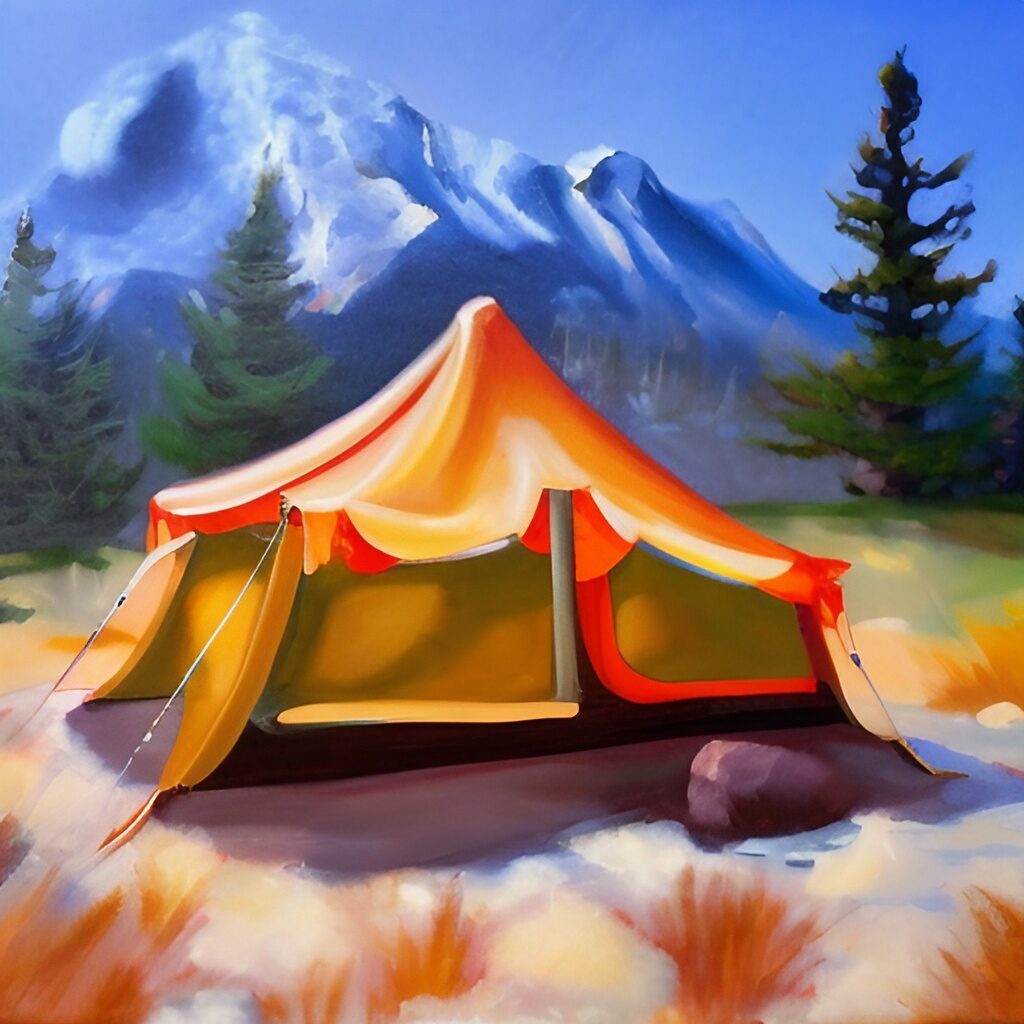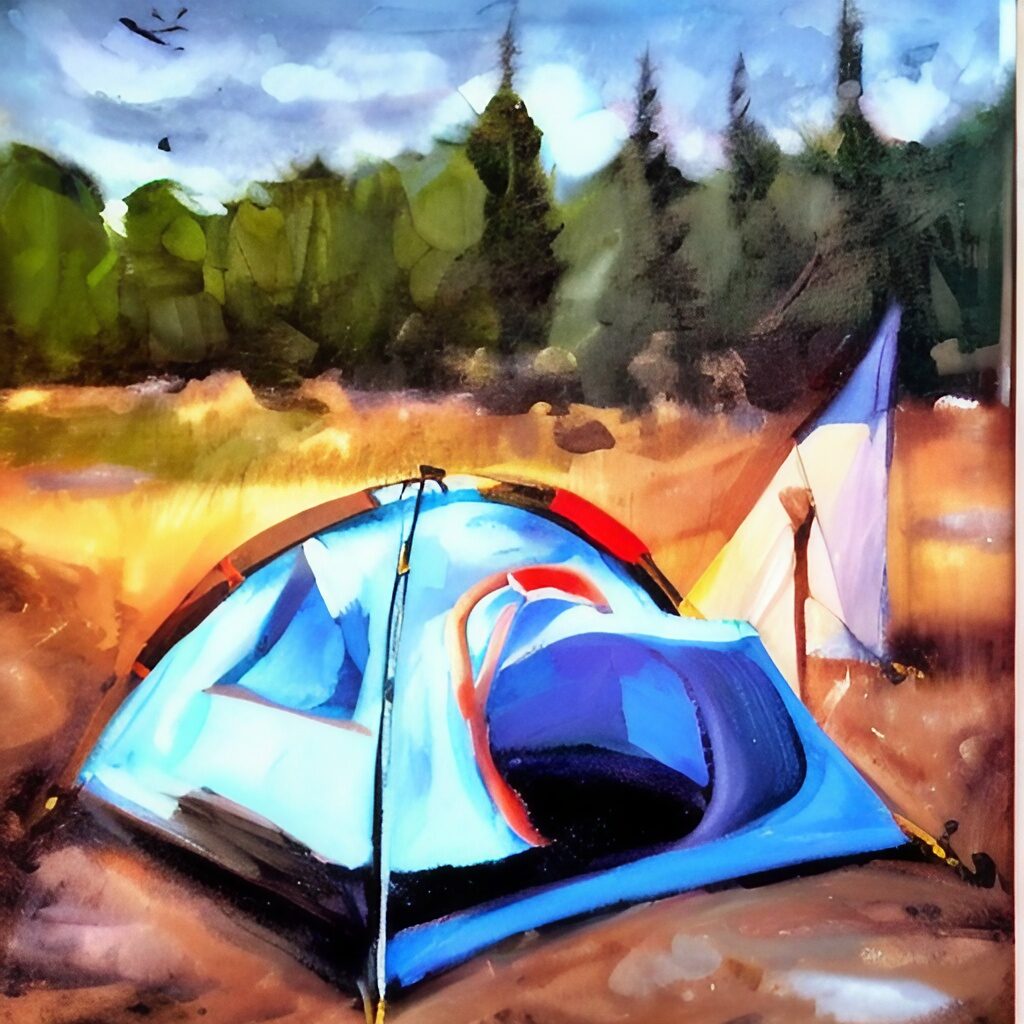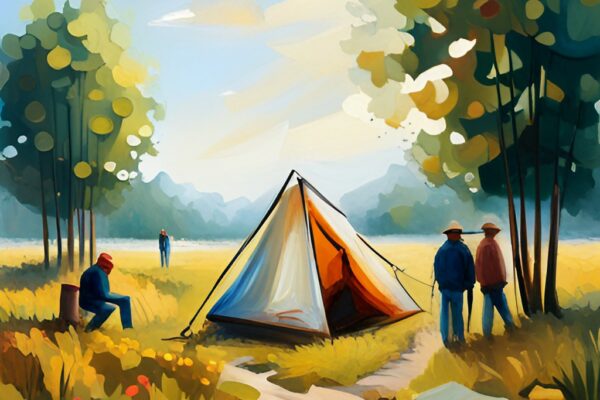
Bivy vs tent – what kind of shelter is better for your camping, backpacking, hiking, or biking trips?
Back in the day, it was simple. Bivy sacks were used by soldiers and climbers while tents and RVs were a common choice for hiking, backpacking, and camping.
Since then, tent and bivy bags have improved immensely. Both types of shelters are suitable for lightweight outdoor activities. So, which one suits you better?
A bivy is a better choice if staying minimalistic is your top priority. A bivy is lighter, more compact, easier to set up, and offers more flexibility than a tent. However, if comfort is anywhere near the top of your priorities, a tent is likely a better choice.
Our team is here to help you. We have seen almost all of them and tried many. We’ve spent 12+ hours researching and scouring the internet, checking out other people’s opinions and experiences.
comparison table – Bivy vs Tent
| Bivy | Tent | ||
| Setup | Usually less than a minute | From a minute to 30-40 minutes | |
| Available space | One person and a sleeping bag. No spare room | Wide range. It provides space for sleeping, sitting, and storing some gear at leastPicking a camping spotCan roll it out almost anywhereLimited by tent size, terrain, and local laws ComfortNot very comfortableComfortableWeight5 oz. to 2 lbs. | Anywhere between 2 and 50+ lbs. |
| Packed size | 10-15” x 5-6” | 15-20” x 6-10” (compact backpacking tents) All other tents are larger and bulkier | |
| Weather protection | Depends on the quality. Solid. Commonly water-resistant or waterproof | Depends on quality and purpose. Can be exceptional | |
| Warmth | Retains the warmth well | Majority of tents have no insulation (with the exception of 4-season tents) and can’t retain the heat. | |
| Ventilation | Mediocre. Potential condensation issues | Can be outstanding | |
| Durability | Depends on quality. Can be extremely durable | Depends on quality. Can be very durable | |
| Versatility | It’s a sleeping shelter. No other purposes or options | Very versatile. There’s a tent for every occasion | |
| Price | Wide range. More affordable than tents | Wide range. Can be affordable |
- comparison table – Bivy vs Tent
- Design – Bivy and Tents
- Setup – Bivy vs Tent
- Space – Bivy vs Tent
- Choosing a Camping Spot – Bivy vs Tent
- Comfort – Bivy vs Tent
- Weight and Packed Size – Bivy vs Tent
- Weather Protection – Bivy vs Tent
- Warmth – Bivy vs Tent
- Ventilation – Bivy vs Tent
- Durability – Bivy vs Tent
- Versatility – Bivy vs Tent
- Price – Bivy vs Tent
- Conclusion: Final Verdict – Bivy vs Tent
- Frequently Asked Questions – Bivy vs Tent
- What Exactly is a Bivy? – FAQs
- What Exactly is a Tent? – FAQs
- Which is More Preferable, a Bivy or a Tent? – FAQs
- Can I Substitute a Bivy for a Tent? – FAQs
- Is There Any Disadvantage to Using a Bivy Instead of a Tent? – FAQs
- When Should I Use a Bivy Rather Than a Tent? – FAQs
- How Do I Choose Between Using a Bivy or Tent? – FAQs
- Can My Sleeping Pad Fit in my Bivy Sack? – FAQs
Design – Bivy and Tents
A bivy (also known as bivvy, bivy bag, bivy sack) is short for bivouac shelter. It is the ultimate, single-person, minimalist shelter.
Originally, they were made for military use and climbing expeditions. Militaries around the world used them as emergency, low-profile shelters. Climbers found them very convenient for fast and ultra-light ascents.
Considering the design, there are 2 different types of bivy sacks – the smaller and the larger one.
The smaller is a traditional one and it’s pretty much a waterproof bag for your sleeping bag. It is almost completely enclosed with the exception of the small breathing hole.
Most of them are waterproof or at least water-resistant. Also, they are made of breathable materials to reduce condensation.
Bivy sacks are not too tight, but there’s no room for storing gear. Apart from your sleeping bag and you, the rest of your gear will have to stay in the open air.
The larger bivy is not large either, it is only taller. It comes with a pole(s) to keep the fabric raised above your head.
The pole version provides better ventilation. It’s slightly roomier and more comfortable for those who find traditional bivvies too confining and claustrophobic. Also, it is easier to place a sleeping bag inside the bivy, and to get in or out of it.
As for the tents, well, it would take a whole article to describe all styles and designs.
Tents are also shelters but they provide more than just a sleeping space. Even the most compact and ultra-lightweight backpacking tents have some storage room and allow you to sit in them.
At the other end of the spectrum, there are large, cabin-like, family tents. They can accommodate your whole family and then some.
The bottom line, bivy design focuses on lightweight and portability while providing an additional layer of protection against the elements.
Tent designs vary a lot, but all of them aspire to provide comfort along with protection.
Note there are some hybrid shelters halfway between a tent and bivy like this one.
Setup – Bivy vs Tent
Winner: Bivy
Setting up a bivy is quicker and easier than pitching a tent.
When it comes to setup, it’s difficult to challenge the bivy. Basically, there’s no setup. Laying it on the ground is all it takes. Then you have to put your sleeping bag inside the bivy and get inside. This part can be challenging, but more on that later on.
A bivy shelter with a pole will still take less than a minute to set up.
In the morning, you just have to roll it up and you’re ready to go. Some campers roll it up with a sleeping bag and sleeping pad still inside and just strap it to the backpack.
This strategy is super-fast but there’s a caveat. One needs to make sure there’s no condensation on the bivy fabric, otherwise the sleeping bag can get wet for the next night.
From the Reddit forum “Can you just roll up bivy a with sleeping gear still inside?”
Pitching a tent used to require time and skill. Nowadays, there are instant and popup tents that can be erected in a matter of seconds.
Still, it will take a couple of minutes to stake them down. Freestanding tents don’t require staking, but it should be done anyway to provide more stability. It’s a must in windy conditions.
A conventional tent setup can take anywhere between 10 and 30 minutes or even more. So, different tent designs provide plenty of options regarding setup time. Nevertheless, even the fastest-pitching tents are a fraction behind the bivy sack setup.
Space – Bivy vs Tent
Winner: Tent
Even the smallest tent is larger than a bivy.
A bivy is a minimalist shelter. It provides just enough room to fit you and your sleeping bag. No storage space, no vestibules or any extensions. It is a confined space that can even feel claustrophobic for some people.
A typical bivy measures around 85” by 26”. Those with poles have a peak height of about 20 inches providing some space above your head.
One-person tents can be quite small. Commonly they have 85-90” by 35-40” floor area. So solo-tents have a barely larger footprint than bivies. However they still provide much more room.
They are taller (around 38”) than bivvies and often come with vestibules to keep your gear protected. Vestibules add extra 9-10 sq ft of space. The height allows you to sit in the tent. And we are still talking about extra-small, 1-person tents.
Needless to say, family tents can offer vast space for many occupants, a bunch of gear, and your pets, for full-family camping trips.
Choosing a Camping Spot – Bivy vs Tent
Winner: Bivy
When it comes to picking a campsite, a bivy is second to none. The bivy features allow you the ultimate freedom of choosing a camping spot.
Being so small and easy to set up, you can virtually place it anywhere. You can freely follow your path and set the bivouac wherever the night finds you.
No worries about the rugged terrain or dense vegetation. You may look like a “bear burrito”, but you’ll always find enough space to fit your bivy even in unfavorable landscapes.
As for the tents, choosing a campsite can be challenging. It comes with many limitations.
You have to avoid rocky grounds and need a flat surface. The larger the tent, the more challenging it is to find a fitting spot. Sun and wind exposure should be taken into account.
Also, there are legal restrictions. You can’t just pitch a tent wherever you want even if you like the spot.
Truth be told, some people enjoy looking for and finding a perfect camping spot. It’s not a lot of hassle. Still, it’s nowhere near the ease of picking the spot for the bivy.
Comfort – Bivy vs Tent
Winner: Tent
Tents are way more comfortable than bivvies.
A bivy is not designed to provide extra comfort. True, today’s bivy sacks are more comfortable than they used to be. Materials are getting better, more breathable and the invention of the pole version has upgraded the feel inside the bivy.
But, make no mistake: sleeping in a bivy is a rough experience. This cowboy camping adventure is all about a fast and light journey through the (possibly) harsh wilderness.
It’s a rewarding experience, but it’s not cozy and comfy. The satisfaction comes from elsewhere.
On the other hand, tents are designed to provide maximum comfort under given circumstances.
To begin with, tents are usually large enough to choose the type of bed. A sleeping bag, a cot, or an inflatable air mattress. Compared to sleeping on the ground, an air mattress is a bouncing cloud. If you want to learn more about these sleeping options, check out the article “Camping Cot vs. Air Mattress vs. Sleeping Pad“.
Dozens of tweaks in design allow improved comfort for all kinds of camping experiences. For instance, summer tents use lots of mesh to provide a breezy feel and adequate airflow. Winter tents are insulated to battle the cold.
And then, there are many accessories to make your camping life cozier. Think of multiple doors, hinged doors, mesh ceilings and windows, screen rooms, vestibules, room dividers, storage pockets, nightlights, and so on.
From the 14ers forum “Bivy Sack vs Tent”
Easy Access – Choosing a Camping Spot
The ability to get in or out of the shelter is often underestimated. If you’ve ever slept in a bivy, you know it takes some shuffling and wiggling to get in or out of it. Not a big deal unless it’s raining.
Wrestling with your bivy and sleeping bag while trying to prevent water from getting in can be a frustrating experience.
Tents usually feature large or multiple doors for easy and convenient entrance/exit.
Weight and Packed Size – Bivy vs Tent
Winner: Bivy
Tents can be pretty compact and lightweight, but a bivy is lighter and packs to a ridiculously small size.
This is what bivy is made for – to be ultra-light and compact. Bivy sacks without poles commonly weigh under 1 pound, with the lightest models weighing only 5 to 8 ounces! This is one example.
Bivy bags with a pole(s) typically weigh between 1 and 2 pounds.
Family tents are heavy, some of them exceeding 50 lbs. However, backpacking tents can be very lightweight. The lightest among them weigh between 2 and 3 pounds which is quite impressive. Still, not enough to beat bivy sacks.
Check out our ultimate guide on tent weight, which shows the average weight of 50+ tents and how to know which weight is right for you.
When it comes to packability, bivy bags are as compact as possible. Some of them stuff down to the size of your hand. On average, poleless bivy bags pack down to 10 by 5 inches. Bivy sacks with poles are somewhat “bulkier” at roughly 15 by 5 inches.
Tents come in a variety of packages with the backpacking tents being the most compact ones. The smallest among them can pack down to 15-20 inches by 6-7 inches. Naturally, larger tents are bulkier when packed as well.
At the end of the day, the lightest and most compact tents can barely match heavier and larger bivy sacks. At such a small scale, the difference can be neglected, but the bivy is still a winner.
From the Backpackinglight forum “Poll: Tarp/Bivy vs. Tent”
Weather Protection – Bivy vs Tent
Winner: Tent
This was a very close call, but the best tents can outperform the best bivies, in terms of weather protection that is.
Tents and bivvies use pretty much the same technology and materials to battle the elements.
Bivy sacks are commonly waterproof or water-resistant. Just like tents, the bivy’s ability to repel rain is measured on the HH (Hydrostatic Head) scale.
1000+mm rating will prevent light to moderate rain from entering the bivy. A bivy with a 2000+ mm rating can handle some showers and heavier rain, while a 3000+ mm bivy can handle pretty much anything falling from the sky.
So, in theory, they can be made to withstand the heaviest storms.
But, in practice, there’s a trade-off. Highly waterproof bivvies are less breathable and vice versa. Therefore, the manufacturers try to find the right balance between the two.
Also, a bivy is not a comfortable place to be in rainy conditions. All you can do is lie in it. Getting in or out when it’s raining is not the most pleasant experience either.
On the upside, a bivy sack is better than a tent at battling the winds. The low-profile, small footprint and your weight will hold the bivy in place in windy conditions easily.
Different tents have wildly different weather protection properties depending on the purpose. The best waterproof tents can champion the inclement weather while you can sit and relax, waiting for the storm to pass. Feel free to check out the Best Tents for Bad Weather.
On the other hand, budget-friendly, summer tents can barely handle the lightest summer rains.
Overall, tents exhibit a wide range of protection, but the best of them are nearly almighty and superior to bivy sacks.
From the Reddit forum “Solo Tent vs the Bivy: The showdown of all showdowns (not really, just want some advice)”
Warmth – Bivy vs Tent
Winner: Bivy
This was another tough choice to make, but at the end of the day, a bivy traps and holds more warmth than a tent.
Let’s face it, neither a bivy nor a tent will stay warm and cozy in freezing cold weather. However, the bivy will hold some warmth. Bivvies add another layer and provide almost fully enclosed space.
These characteristics allow it to raise the temperature inside the bivy by 4 to 8 degrees. Furthermore, the bivy is like the windshell jacket for your sleeping bag. It will keep the unpleasant drafts away from you.
Tents can be well insulated, but still, there’s a lot of air inside, and your body is the only thing that produces heat. Okay, some tents come with a stove jack so you can heat them. However, it takes additional equipment and these tents are an exception rather than a rule.
Common tents are not insulated at all and you’ll find yourself shivering in no time when it gets cold.
To sum it up, with some extra gear you can bring warmth into the tent, but without it, bivies retain heat better.
Ventilation – Bivy vs Tent
Winner: Tent
Tents easily provide better ventilation than bivvies.
Back in the day, bivies used to be basically much like large, plastic garbage bags. Nowadays, they are usually made of breathable materials providing a far better sleeping experience.
Still, breathable fabric and a small breathing hole are not enough to provide a decent airflow. While the enclosed design is helpful to stay warmer, condensation can be an issue. Needless to say, waking up damp is far from a nice experience.
To prevent moisture build-up, one should choose more breathable bivvies and make sure not to breathe inside the bivy. In high humidity conditions, it is recommendable to unzip the entrance and let more air in.
As for the tents, ventilation shouldn’t be an issue. Summer tents usually have plenty of mesh panels to provide constant airflow. Many models come with ground vents to enhance the ventilation.
Tent rainflies often have vent openings. There should be some space left between the rainfly and the inner tent to provide airflow whenever you need to keep the rainfly on.
So, not all tents are condensation-free, but overall, they provide much better ventilation than bivies.
From the Rockslide forum “Breathable goretex bivvys?”
Durability – Bivy vs Tent
Winner: Bivy
In terms of durability, there’s a very small margin, but my vote goes to bivvies.
As I have already said, lightweight tents and bivvies are made from very similar if not the same materials. It’s a lightweight, but relatively strong nylon.
Like tents, bivies typically have reinforced floors to resist abrasion and keep the ground water out of the shelter. A low profile and small footprint reduce the possibility of accidental tears.
Also, the bivy is exposed for shorter amounts of time. You only use it for sleep and pack it up during the day. So, the “working” hours are less than half in comparison to tents.
Truth be told, these minor advantages aren’t significant. It is the lack of poles that tips the scale in favor of bivvies. Yes, some bivies come with one or two poles, but they are rather short and not under immense pressure.
Tents can be very durable, but broken or bent poles are the most common tent malfunctions. Sometimes it is possible to fix or replace damaged poles but it depends on the design.
Note, it is very important to store both tents and bivvies, properly. It means they have to be clean and dry before you put them away until the next adventure.
So, high-quality tents and bivvies can last for years, but on average, bivvies are more reliable.
Versatility – Bivy vs Tent
Winner: Tent
Even though bivvies have some trump cards, tents are more versatile.
A bivy is a shelter to spend a night at, end of the story. It can’t fulfill any other purposes. Apart from blending into the environment and feeling more connected to nature, there aren’t other possibilities of having fun in the bivy.
On the upside, it does provide unmatched versatility to pick a spot. But, that’s where versatility stops.
Tents, on the other hand, are extremely versatile. Think of any landscape, any climate, or altitude, you’ll find a tent designed to fit in.
Large cabin tents feel like a home-away-from-home where you can lounge, cook, or play camping games. Backpacking tents are ultra-light to save your back on your fast-moving missions.
Summer tents, winter tents, waterproof tents, I can go on, but you get the picture already, right?
Even individual tent models can be very versatile to suit different camping styles and occasions.
Price – Bivy vs Tent
Winner: Bivy
When it comes to pricing, babies are more affordable than tents. However, a huge price range for both products can be confusing.
This is how it goes. The price range extends from under $20 to $300+. With bivvies, it is pretty much true that you get what you pay for. More expensive bivvies are usually more breathable and provide better waterproofness.
Some people like to have bivvies only as a backup, emergency shelter. If so, you don’t have to spend a fortune to carry a piece of equipment that you hope you’ll never use. And any bivy sack will come in handy in an emergency situation.
Tent prices also differ wildly. Budget-friendly, basic options start at around $40 and there’s almost no upper limit. Typically, high-end tents cost around $400 or more. We have a comprehensive guide on how much you should spend on a tent.
Similar to bivy users, occasional campers can settle for more affordable options, while avid campers will probably end up buying top-notch models sooner or later.
While an individual tent can be cheaper than a bivy, on average, tents are more expensive.
If you are comparing models of similar class, craftsmanship, and quality, the tent will always cost more. It is only natural – the tent requires more materials, more poles, and a more sophisticated design.
Conclusion: Final Verdict – Bivy vs Tent
If you’ve made it so far, you probably know the verdict already. Tents and bivvies have different basic purposes so no one wins this race. Or the winner depends on the buyer’s preferred outdoor activities.

To sum it up, you should choose a bivy if:
- You want to shed every pound on your travels.
- You prefer the ultimately minimalist approach.
- You like solo, fast, and ultra-light outdoor missions.
- You want to feel more connected to nature.
- You like to sleep under the stars.
- You plan big wall climbing or swift alpine ascents.
And the tent is a better option for you if:
- You want enough space to sit or move around.
- You prioritize comfort.
- You like to carry more gear.
- You need some privacy on camping trips.
- You like group camping trips.
- You prefer to taste the wilderness without giving up all amenities of modern life.
If you’re an outdoor aficionado there’s another option. You can get both! Lounging at the campground with your friends or running through the wilderness? Both experiences can enrich your life. It’s your choice now.
Frequently Asked Questions – Bivy vs Tent
What Exactly is a Bivy? – FAQs
A bivy, short for “bivouac sack,” is a simple shelter that protects only your sleeping bag from the elements.
What Exactly is a Tent? – FAQs
A tent is a portable shelter made of fabric and poles that provides more space and protection from the elements than a bivy.
Which is More Preferable, a Bivy or a Tent? – FAQs
This question’s answer is dependent on personal preference, intended use, and weather conditions. A bivy is lighter and more compact, but it has less space and can be claustrophobic, whereas tents have more space but are heavier to carry.
Can I Substitute a Bivy for a Tent? – FAQs
Yes, if you’re looking for lightweight and compact shelter options, you can use a bivy instead of a tent; however, it may not be as comfortable as a full-sized tent.
Is There Any Disadvantage to Using a Bivy Instead of a Tent? – FAQs
Yes, there are some disadvantages to using a bivy over a tent, such as less protection from the elements and less ventilation, which causes moisture buildup inside the bag, making it uncomfortable.
When Should I Use a Bivy Rather Than a Tent? – FAQs
Bivys are ideal for ultralight backpacking trips where weight and pack size are important or for camping in areas with limited flat ground suitable for tent pitching.
How Do I Choose Between Using a Bivy or Tent? – FAQs
Consider weather conditions, intended use case scenario (camping location), personal preferences on comfort level versus weight reduction, and other factors before deciding on the best option for you.
Can My Sleeping Pad Fit in my Bivy Sack? – FAQs
Most Bivys have enough room for your sleeping pad, but it’s important to double-check the dimensions before buying.
















